skip to main |
skip to sidebar
Occasionally I buy a bag of “monkey nuts” from the supermarket, because I love me some boiled goobers, I do. Aren’t both those weird terms for peanuts? Monkey nuts are sort of descriptive, therefore understandable - but goobers? I wonder who was the first person who picked up a bunch of the infinity-shaped shells, broke ‘em, took out the red nuts inside and thought “Oh yeah, I know those things! They’re goobers!”
The more you say the "goobers", the more absurd it sounds. But the more absurd it sounds, the more I want to say it, simply because it’s absurd. Eventually I have to stop, though, because people tend to look at me strangely and cross to the other side of the road. I don’t understand why they do that. And when I follow them to explain that I’m merely getting some harmless amusement out of a weird word, they walk away even faster. Strange phenomenon, that...
Anyway, I usually pressure-cook the unshelled peanuts. You can put them in salted water to cook them, but I mostly don’t bother because I like the natural taste of the cooked peanuts hot from the shells. They still taste good when they cool down, don’t get me wrong. I like adding the cold peanuts to salads for texture and protein.
For a change, I made dal with the boiled peanuts. I usually pressure-cook the raw peanuts along with the dal if I’m using tuvar or masoor, where it doesn’t matter if the longer cooking time mushes up the dal entirely. But if chana dal features in the recipe, the peanuts stay separate. Since I’ve used a mixture of masoor and chana dal in this recipe, I cooked the peanuts separately. The reason is that the peanuts take longer to cook than the dals. I like the masoor dal cooked to shapelessness and the chana dal to retain its shape, and putting the two together in a pressure cooker for 3 quick whistles cooks them both just the way I like them. Peanuts don’t figure in this equation, so they get cooked separately.
Now, if we’re all unanimous that I have belaboured that point quite thoroughly, I will move on to the recipe.
Recipe for: Boiled peanut dal
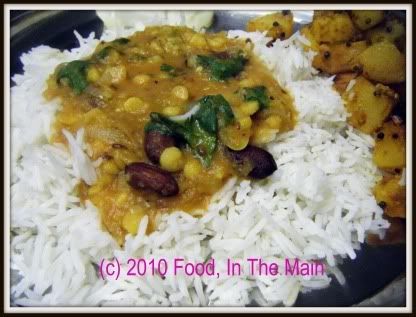 Ingredients:
1/2 cup peanuts, boiled
1/2 cup masoor dal
1/4 cup chana dal
2 small onions, sliced thin
3-4 green chillies (or to taste), sliced in thin strips
1 tsp ginger-garlic paste
1/2 cup roasted tomatoes, mashed
1/2 tsp cumin powder
1 tsp coriander powder
1/4 tsp turmeric powder
1 tsp garam masala/Kitchen King masala
3 tsp oil
Salt to taste
Coriander leaves for garnish
Method:
1. Heat the oil and add the ginger-garlic paste and green chillies. Fry this for 30 seconds, then add the cumin and coriander powder along with the sliced onions.
2. Fry the onions till they start turning soft and translucent. Now add the roasted tomatoes and mash it all with a spatula.
3. Stir-fry the masala for 2-3 minutes, then stir in the boiled peanuts.
Ingredients:
1/2 cup peanuts, boiled
1/2 cup masoor dal
1/4 cup chana dal
2 small onions, sliced thin
3-4 green chillies (or to taste), sliced in thin strips
1 tsp ginger-garlic paste
1/2 cup roasted tomatoes, mashed
1/2 tsp cumin powder
1 tsp coriander powder
1/4 tsp turmeric powder
1 tsp garam masala/Kitchen King masala
3 tsp oil
Salt to taste
Coriander leaves for garnish
Method:
1. Heat the oil and add the ginger-garlic paste and green chillies. Fry this for 30 seconds, then add the cumin and coriander powder along with the sliced onions.
2. Fry the onions till they start turning soft and translucent. Now add the roasted tomatoes and mash it all with a spatula.
3. Stir-fry the masala for 2-3 minutes, then stir in the boiled peanuts.
 4. Add the cooked dals and mix well. Add 1/3 cup water if the dal seems too thick.
4. Add the cooked dals and mix well. Add 1/3 cup water if the dal seems too thick.
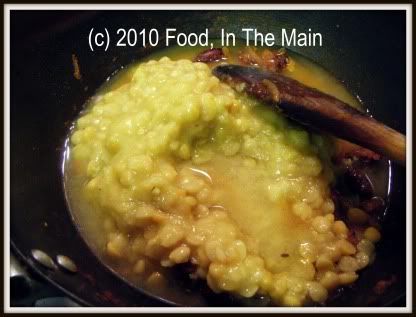 5. Stir well once again, add salt to taste, and bring the dal to a gentle boil on medium heat.
6. Now sprinkle the garam masala, turn the heat to low and let the dal simmer for 6-7 minutes.
5. Stir well once again, add salt to taste, and bring the dal to a gentle boil on medium heat.
6. Now sprinkle the garam masala, turn the heat to low and let the dal simmer for 6-7 minutes.
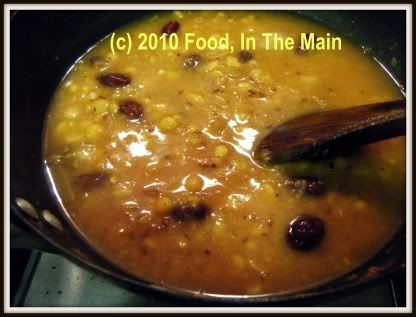 Garnish with coriander leaves and serve hot with rice or rotis.
RECIPE: BOILED PEANUT DAL
Ingredients:
1/2 cup raw peanuts
1/2 cup masoor dal
1/4 cup chana dal
2 small onions, sliced thin
3-4 green chillies (or to taste), sliced in thin strips
1 tsp ginger-garlic paste
1/2 cup roasted tomatoes, mashed
1/2 tsp cumin powder
1 tsp coriander powder
1/4 tsp turmeric powder
1 tsp garam masala/Kitchen King masala
3 tsp oil
Salt to taste
Coriander leaves for garnish
Method:
1. Heat the oil and add the ginger-garlic paste and green chillies. Fry this for 30 seconds, then add the cumin and coriander powder along with the sliced onions.
2. Fry the onions till they start turning soft and translucent. Now add the roasted tomatoes and mash it all with a spatula.
3. Stir-fry the masala for 2-3 minutes, then stir in the boiled peanuts.
4. Add the cooked dals and mix well. Add 1/3 cup water if the dal seems too thick.
5. Stir well once again, add salt to taste, and bring the dal to a gentle boil on medium heat.
6. Now sprinkle the garam masala, turn the heat to low and let the dal simmer for 6-7 minutes. Garnish with coriander leaves and serve hot with rice or rotis.
Garnish with coriander leaves and serve hot with rice or rotis.
RECIPE: BOILED PEANUT DAL
Ingredients:
1/2 cup raw peanuts
1/2 cup masoor dal
1/4 cup chana dal
2 small onions, sliced thin
3-4 green chillies (or to taste), sliced in thin strips
1 tsp ginger-garlic paste
1/2 cup roasted tomatoes, mashed
1/2 tsp cumin powder
1 tsp coriander powder
1/4 tsp turmeric powder
1 tsp garam masala/Kitchen King masala
3 tsp oil
Salt to taste
Coriander leaves for garnish
Method:
1. Heat the oil and add the ginger-garlic paste and green chillies. Fry this for 30 seconds, then add the cumin and coriander powder along with the sliced onions.
2. Fry the onions till they start turning soft and translucent. Now add the roasted tomatoes and mash it all with a spatula.
3. Stir-fry the masala for 2-3 minutes, then stir in the boiled peanuts.
4. Add the cooked dals and mix well. Add 1/3 cup water if the dal seems too thick.
5. Stir well once again, add salt to taste, and bring the dal to a gentle boil on medium heat.
6. Now sprinkle the garam masala, turn the heat to low and let the dal simmer for 6-7 minutes. Garnish with coriander leaves and serve hot with rice or rotis.
My husband loves fruitcake in all forms – heavy and dense, light and fluffy, dry and crumbly, with exotic dried fruit or just with currants, with nuts or without, egg-free or eggful, fancy or homely, buzzing with alcohol or completely teetotal… you name it, he’ll eat it. Of course it goes without saying that he prefers fruitcake that's well-made to one that's second-rate... but in a pinch he'll eat the second-rate one too. In general he can be as nutty as a – pardon me for this – fruitcake when it comes to this variety of cake. Me, on the other hand… I can take fruitcake or leave it. It’s marginally more “take it” if it’s got nuts in it that cut the sweetness of all the dried fruit, so I usually add some to most fruitcakes I make.
And because Pete mostly doesn’t mind how his fruitcake turns out, as long as it’s not turned to coal, I feel free to experiment without worrying about “what ifs” like “what if the cake’s heavy like a brick”, or “what if it’s so crumbly that you choke on fruitcake dust”, and so on. (I’ve even made fruitcake with dark chocolate that needs to see the light of day at some point.)
Anyway, this cake combines the best of what Pete likes (dried fruit) with the best of what I like (banana) with some dried sour cherries (bought in the YewYessYay, naturally) thrown in for that “exotic” touch. The addition of mashed overripe bananas was a touch of genius if I do say so myself, because the flavour it gave the fruitcake – helped by the addition of cardamom powder – was luvverly. It was almost like an Indian fruitcake, if there is such a thing. If there isn’t, there is now.
The cake keeps well and stays moist at room temperature (under cover, that is, not left open to the elements) for at least a week that I can vouch for. We both think it tastes gorgeous too – let me put it this way, we’re all three made for each other because if he’s nutty about banana fruitcake, I’m bananas about nutty fruitcake, and the fruitcake is bananas and nuts anyway. See what I mean?
Recipe for: Banana almond fruitcake
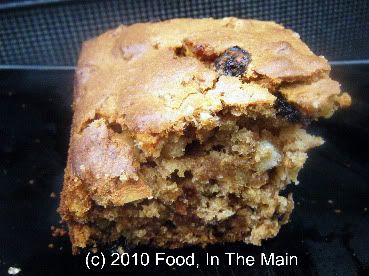 Ingredients:
2 medium overripe bananas, mashed well
1-1/2 cups plain flour or wholewheat cake flour
1/4 tsp salt
1/2 tsp cinnamon powder
1/4 tsp ground cardamom seeds
1/2 cup butter or margarine, softened
1/2 cup Splenda 1/4 cup sugar
2 cups dried fruit (I used currants, dried sour cherries, chopped mixed citrus peel)
1/4 cup almond slivers
1 cup + 2 tbsp milk (or as needed)
1 tsp bicarbonate of soda 1/2 tsp baking powder
Method:
1. Sift the flour and spices together with the Splenda, sugar and salt. 2. Add the dried fruit
Ingredients:
2 medium overripe bananas, mashed well
1-1/2 cups plain flour or wholewheat cake flour
1/4 tsp salt
1/2 tsp cinnamon powder
1/4 tsp ground cardamom seeds
1/2 cup butter or margarine, softened
1/2 cup Splenda 1/4 cup sugar
2 cups dried fruit (I used currants, dried sour cherries, chopped mixed citrus peel)
1/4 cup almond slivers
1 cup + 2 tbsp milk (or as needed)
1 tsp bicarbonate of soda 1/2 tsp baking powder
Method:
1. Sift the flour and spices together with the Splenda, sugar and salt. 2. Add the dried fruit
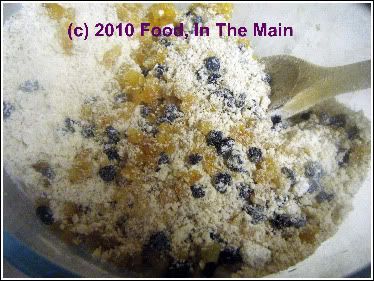 and the dried cherries, mix them into the flour.
and the dried cherries, mix them into the flour.
 3. Make a well in the flour-fruit mix, then add the almond slivers and the mashed banana.
3. Make a well in the flour-fruit mix, then add the almond slivers and the mashed banana.
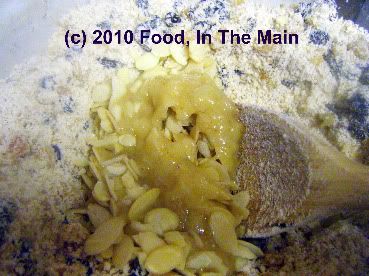 Mix again.
4. Add milk little by little, mixing as you go.
Mix again.
4. Add milk little by little, mixing as you go.
 The batter should be thick. It is the correct consistency when it drips slowly off the back of a spoon. Mix in more milk if it's too thick, to get it to the right consistency,
The batter should be thick. It is the correct consistency when it drips slowly off the back of a spoon. Mix in more milk if it's too thick, to get it to the right consistency,
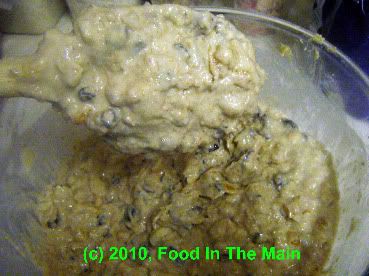 5. Pour the batter into an 8" square or round pan sprayed with Pam or greased with butter.
5. Pour the batter into an 8" square or round pan sprayed with Pam or greased with butter.
 Bake at 180C for about an hour, or till the cake tests done. Start checking at the 45-minute mark as different ovens work differently. 6. Remove the cake tin from the oven, and let the cake sit in the tin for 10 minutes.
Bake at 180C for about an hour, or till the cake tests done. Start checking at the 45-minute mark as different ovens work differently. 6. Remove the cake tin from the oven, and let the cake sit in the tin for 10 minutes.
 7. Unmould the cake onto a wire cooling rack and let cool completely. This cake stays good at room temperature for a few days.
RECIPE: EGGLESS BANANA ALMOND FRUITCAKE
Ingredients:
2 overripe bananas, mashed
1-1/2 cups plain flour
1/4 tsp salt
1/2 tsp ground cinnamon
1/4 tsp ground cardamom seeds
1/2 cup butter or margarine, softened
1/2 cup Splenda
1/4 cup sugar
2 cups dried fruit (currants, dried sour cherries, chopped mixed citrus peel)
1/4 cup almond slivers
1 cup + 2 tbsp milk (or as needed)
1 tsp bicarbonate of soda
1/2 tsp baking powder
Method:
1. Sift the flour and spices together with the Splenda, sugar and salt.
2. Add the dried fruit and the dried cherries, mix them into the flour.
3. Make a well in the flour-fruit mix, then add the almond slivers and the mashed banana. Mix again.
4. Add milk little by little, mixing as you go. The batter should be thick. It is the correct consistency when it drips slowly off the back of a spoon. Mix in more milk if it's too thick, to get it to the right consistency,
5. Pour the batter into an 8" square or round pan sprayed with Pam or greased well with butter. Bake at 180C for about an hour, or till the cake tests done. Start checking at the 45-minute mark as different ovens work differently.
6. Remove the cake tin from the oven, and let the cake sit in the tin for 10 minutes.
7. Unmould the cake onto a wire cooling rack and let cool completely. This cake stays good at room temperature for a few days.
7. Unmould the cake onto a wire cooling rack and let cool completely. This cake stays good at room temperature for a few days.
RECIPE: EGGLESS BANANA ALMOND FRUITCAKE
Ingredients:
2 overripe bananas, mashed
1-1/2 cups plain flour
1/4 tsp salt
1/2 tsp ground cinnamon
1/4 tsp ground cardamom seeds
1/2 cup butter or margarine, softened
1/2 cup Splenda
1/4 cup sugar
2 cups dried fruit (currants, dried sour cherries, chopped mixed citrus peel)
1/4 cup almond slivers
1 cup + 2 tbsp milk (or as needed)
1 tsp bicarbonate of soda
1/2 tsp baking powder
Method:
1. Sift the flour and spices together with the Splenda, sugar and salt.
2. Add the dried fruit and the dried cherries, mix them into the flour.
3. Make a well in the flour-fruit mix, then add the almond slivers and the mashed banana. Mix again.
4. Add milk little by little, mixing as you go. The batter should be thick. It is the correct consistency when it drips slowly off the back of a spoon. Mix in more milk if it's too thick, to get it to the right consistency,
5. Pour the batter into an 8" square or round pan sprayed with Pam or greased well with butter. Bake at 180C for about an hour, or till the cake tests done. Start checking at the 45-minute mark as different ovens work differently.
6. Remove the cake tin from the oven, and let the cake sit in the tin for 10 minutes.
7. Unmould the cake onto a wire cooling rack and let cool completely. This cake stays good at room temperature for a few days.
What do you call something that’s not quite a Kerala-style thoran and not quite a Tamil-Nadu-style sundal, something for which you don’t have a South Indian term really? Give it a North Indian name, of course, because the term "curry" isn't the perfect description either. So that’s why this is a spinach-chana dal sabji.
You can cook the chana dal separately in a pressure cooker, in which case you’ll need a couple of steps from the recipe below. That is to say, once you've followed Step 1 and popped the mustard seeds, add the spinach and just 1/4 cup water and let it cook till the spinach is wilted. Then add the pressure-cooked chana dal and go directly to Step 5.
To quote a certain once-cute and now-irritating meerkat – seemples!
Recipe for: Spinach-chana dal sabji
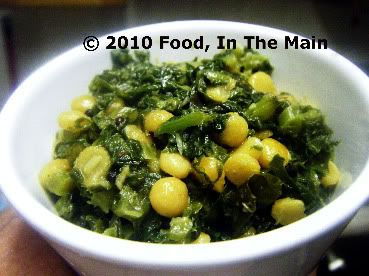 Ingredients:
4 cups spinach, chopped
1/2 cup chana dal
1-1/4 cups water
1 tsp mustard seeds
4-5 fresh curry leaves
1/4 tsp asafoetida powder
2 tsp oil
Grind to a smooth paste:
2 tbsp grated coconut
3-4 green chillies (or to taste
2 shallots
1 cm piece fresh ginger root
Method:
1. Heat the oil, then add asafoetida, curry leaves and mustard seeds and let the seeds pop. Then add the raw chana dal and fry for 3-4 minutes.
Ingredients:
4 cups spinach, chopped
1/2 cup chana dal
1-1/4 cups water
1 tsp mustard seeds
4-5 fresh curry leaves
1/4 tsp asafoetida powder
2 tsp oil
Grind to a smooth paste:
2 tbsp grated coconut
3-4 green chillies (or to taste
2 shallots
1 cm piece fresh ginger root
Method:
1. Heat the oil, then add asafoetida, curry leaves and mustard seeds and let the seeds pop. Then add the raw chana dal and fry for 3-4 minutes.
 2. Pour in the water and bring it to a brisk boil on high heat. Let it boil for 2 minutes, then turn down the heat and let the dal simmer till it is cooked (10-15 minutes).
2. Pour in the water and bring it to a brisk boil on high heat. Let it boil for 2 minutes, then turn down the heat and let the dal simmer till it is cooked (10-15 minutes).
 The dal should be translucent - easy to squash between finger and thumb but still retaining its shape.
The dal should be translucent - easy to squash between finger and thumb but still retaining its shape.
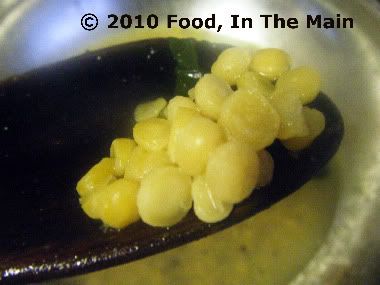 3. Now add the spinach and stir it well.
3. Now add the spinach and stir it well.
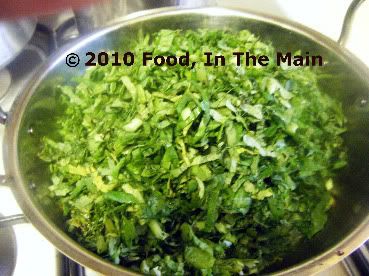 4. Cover the pan and let it cook on low heat for 5 minutes or till the spinach is wilted.
4. Cover the pan and let it cook on low heat for 5 minutes or till the spinach is wilted.
 5. Now stir in the ground coconut masala. Make sure it is mixed in well.
5. Now stir in the ground coconut masala. Make sure it is mixed in well.
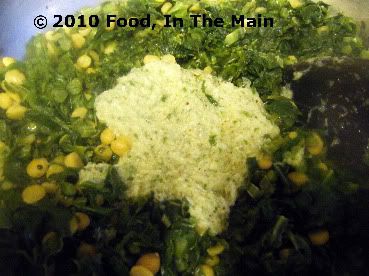
Let the spinach cook for another 2-3 mintes. Serve as a side dish with rotis or chapaties.
RECIPE: SPINACH-CHANA DAL SABJI
Ingredients:
4 cups spinach, chopped
1/2 cup chana dal
1-1/4 cups water
1 tsp mustard seeds
4-5 fresh curry leaves
1/4 tsp asafoetida powder
2 tsp oil
Salt to taste
Grind to a smooth paste:
2 tbsp grated coconut
3-4 green chillies (or to taste
2 shallots
1 cm piece fresh ginger root
Method
1. Heat the oil, then add asafoetida, curry leaves and mustard seeds and let the seeds pop. Then add the raw chana dal and fry for 3-4 minutes.
2. Pour in the water and bring it to a brisk boil on high heat. Let it boil for 2 minutes, then turn down the heat and let the dal simmer till it is cooked (10-15 minutes).
The dal should be translucent - easy to squash between finger and thumb but still retaining its shape
3. Now add the spinach and stir it well.
4. Cover the pan and let it cook on low heat for 5 minutes or till the spinach is wilted.
5. Now stir in the ground coconut masala. Make sure it is mixed in well.
Let the spinach cook for another 2-3 minutes. Serve as a side dish with rotis or chapaties.
I love getting my hands on the “chinna vengayam” (Tamil for “little onions”), also known as sambar onions. I guess they’re a variety of shallots common in India - pungent, purple and perfect for sambar, especially arachuvitta sambar(hence the description “sambar onions”). While I can and do get SOME Indian vegetables from an online Indian grocery site and expect them to be in reasonably good condition, I’ve been wary of buying these little purple fellas – mainly because the site itself warns buyers that “due to bad weather and other unfavourable conditions, the quality of these onions is not good” – or words to that effect. If the sellers themselves describe the onions as “not good”, I figure they’re practically rotting from the inside out (the onions, not the sellers), as onions do.
So a trip to London with Pete is always made the more exciting because I know that I’ll get the chance to visit a Sri Lankan shop and gloat over all the authentic South Indian produce – podalangai (snake gourd), palakottai (jackfruit seeds), chenai kizhangu (elephant yam) and so on. I don’t always buy these vegetables; hell, I may not even like some of them, but I certainly like the fact that, if I suddenly developed a craving for any or all of them, I could indulge myself. The fact that the vegetables are all available is what I find thrilling.
Anyway, I never come away from the Sri Lankan shops without buying about a kilo of the chinna vengayam. As I’ve said in other posts, they’re not fun to peel, being fiddly little things that leave your fingers and nails smelly for a while. But they’re worth the time and effort, because of their flavour and taste. Plus, once they’re peeled, they can be placed in a Ziploc bag in the vegetable compartment of the fridge… and they stay good for at least a month, ready for use. Sambar made with these little shallots is SO special!
They’re also, as I discovered, absolutely lovely in coconut chutney. This is possibly the simplest chutney ever, because it involves no cooking. And if you don’t want to do the tadka or seasoning, it’s simpler still. With these shallots, a little goes a long way so I only needed a few for the chutney… but the delicate flavour and aroma they added was awesome. Yum.
Recipe for: Raw-shallot coconut chutney
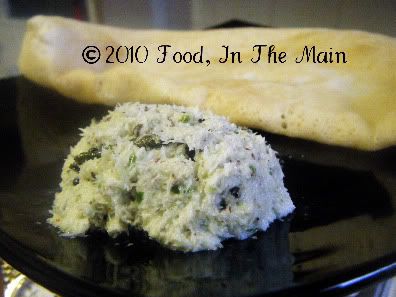
Ingredients:
1/4 cup grated fresh or frozen coconut
3-4 green chillies (or to taste)
3 or 4 small shallots
1 tsp oil
1/2 tsp mustard seeds
1/2 tsp urad dal
4-5 fresh or frozen curry leaves
a pinch asafoetida powder
salt to taste
Method:
1. Grind the coconut, shallots and chillies together with a little hot water, till smooth.
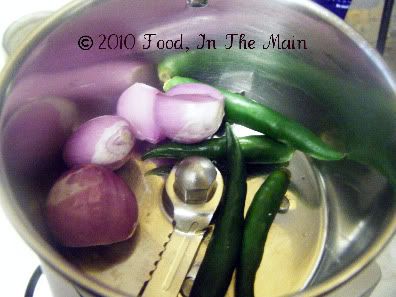
Remove to a serving bowl.
2. Heat the oil in a small pan and add the asafoetida powder, mustard seeds, urad dal and curry leaves. Cover the pan and let the mustard seeds pop, then uncover and stir. When the dal is pale golden brown, turn off the heat.
3. Pour over the ground coconut mixture,

add salt to taste and stir till well mixed.
Serve with dosas, idlis, upma, chapaties etc.
RECIPE: RAW SHALLOT COCONUT CHUTNEY
Ingredients:
1/4 cup grated fresh or frozen coconut
3-4 green chillies (or to taste)
3 or 4 small shallots
1 tsp oil
1/2 tsp mustard seeds
1/2 tsp urad dal
4-5 fresh or frozen curry leaves
a pinch asafoetida powder
salt to taste
Method:
1. Grind the coconut, shallots and chillies together with a little hot water, till smooth. Remove to a serving bowl.
2. Heat the oil in a small pan and add the asafoetida powder, mustard seeds, urad dal and curry leaves. Cover the pan and let the mustard seeds pop, then uncover and stir. When the dal is pale golden brown, turn off the heat.
3. Pour over the ground coconut mixture, add salt to taste and stir till well mixed.
Serve with dosas, idlis, upma, chapaties etc.























